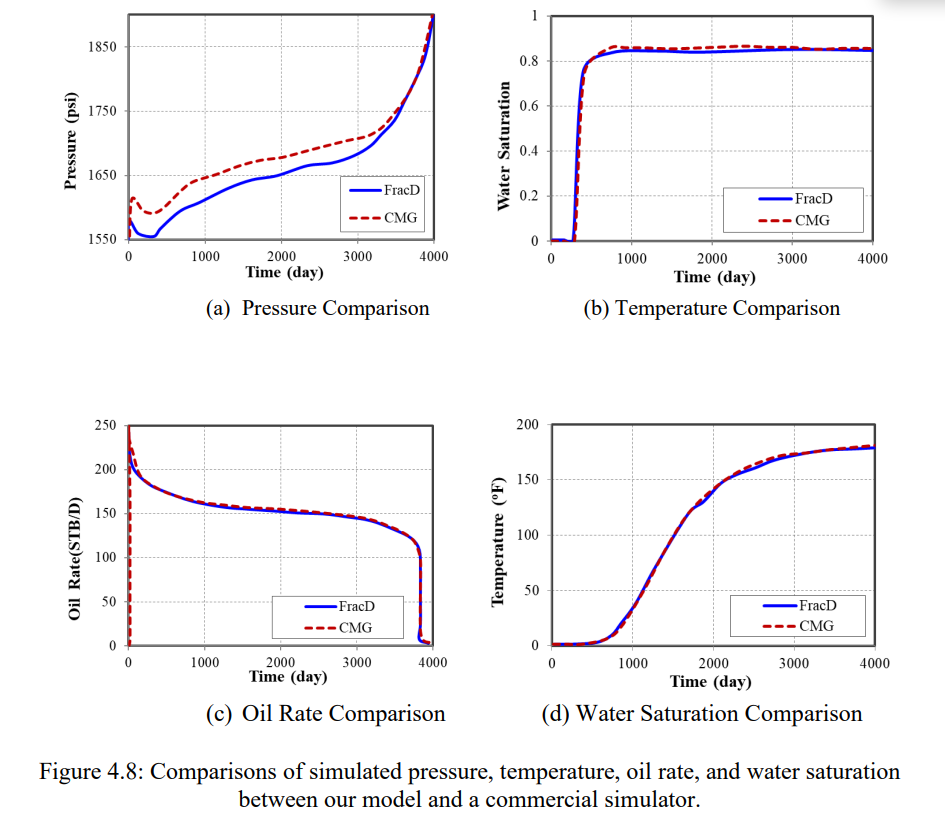IMPLEMENTATION AND APPLICATION OF FRACTURE DIAGNOSTIC TOOLS: FIBER OPTIC SENSING AND DIAGNOSTIC FRACTURE INJECTION TEST (DFIT)
近年来,页岩储层在油气工业引起了广泛关注。水力压裂是开采页岩储层油气的关键技术。复杂的人工裂缝和天然裂缝网络使得裂缝和低渗透储层之间有较大的接触面积,以提高产量。复杂裂缝几何形状的表征和裂缝性质的评价对压裂作业设计和裂缝性储层模拟至关重要。更好地理解裂缝和页岩储层基质的主要方法是裂缝诊断。裂缝诊断技术主要有五种:分布式光纤测温(DTS)、分布式声波传感(DAS)、裂缝注入诊断试验(DFIT)、微震和示踪剂返排试验。在本研主要关注DTS和DFIT的数据解释模型。 目前对DTS数据的解释大多局限于定性分析。为了对DTS数据进行定量解释,开发了一个内部综合模型来评估裂缝性质和几何形状。模型将裂缝、井筒和储层域耦合在一起,以捕获生产阶段的完整物理过程。利用该模型分析了储层参数、裂缝参数和裂缝几何形状对井筒温度剖面的影响。我们的正演模型有可用于描述裂缝参数或裂缝几何特征,并进行历史拟合。 DFIT由裂缝闭合前分析和闭合后分析组成。通过DFIT数据分析,可以得到漏失系数、注入效率、储层基质渗透率和初始孔隙压力。在本研究中,整合了多种DFIT数据解释模型。我们的工作流程成功地分析了Marcellus页岩气DFIT数据。
Abstract
Shale reservoirs have drawn much attention in recent years in the oil and gas industry. Hydraulic fracturing is a key technology to extract the trapped hydrocarbon in the shale reservoirs. The complex hydraulic and natural fracture networks enable large contact area between fracture and low-permeability reservoir to enhance the production. The characterization of complex fracture geometry and evaluation of fracture properties are crucial to the fracturing operation design and fractured reservoir simulation. The main approach to a better understanding of fracture and shale reservoir matrix is fracture diagnosis. There are mainly five fracture diagnostic technologies: Distributed Temperature Sensing (DTS), Distributed Acoustic Sensing (DAS), Diagnostic Fracture Injection Test (DFIT), microseismic, and tracer flow-back test. In this study, we mainly focus on the data interpretation model of DTS and DFIT.
The current interpretation of DTS data is mostly limited to the qualitative analysis. To enable the quantitative interpretation of DTS data, an in-house comprehensive model is developed to evaluate the fracture properties and geometry. Our model couples fracture, wellbore, and reservoir domain together to capture the full physical process during the production stage. The effects of reservoir parameters, fracture parameters, and fracture geometries on temperature profiling along the wellbore are analyzed with our model. Our forward model could be potentially used to characterize fracture parameters or fracture geometry with history matching.
DFIT is consisted of before closure analysis and after closure analysis. The leakoff coefficient, injection efficiency, reservoir matrix permeability, and initial pore pressure can be obtained from DFIT data analysis. In this study, several models for DFIT data interpretation were integrated. A Marcellus shale gas DFIT data is successfully analyzed with our workflow.


